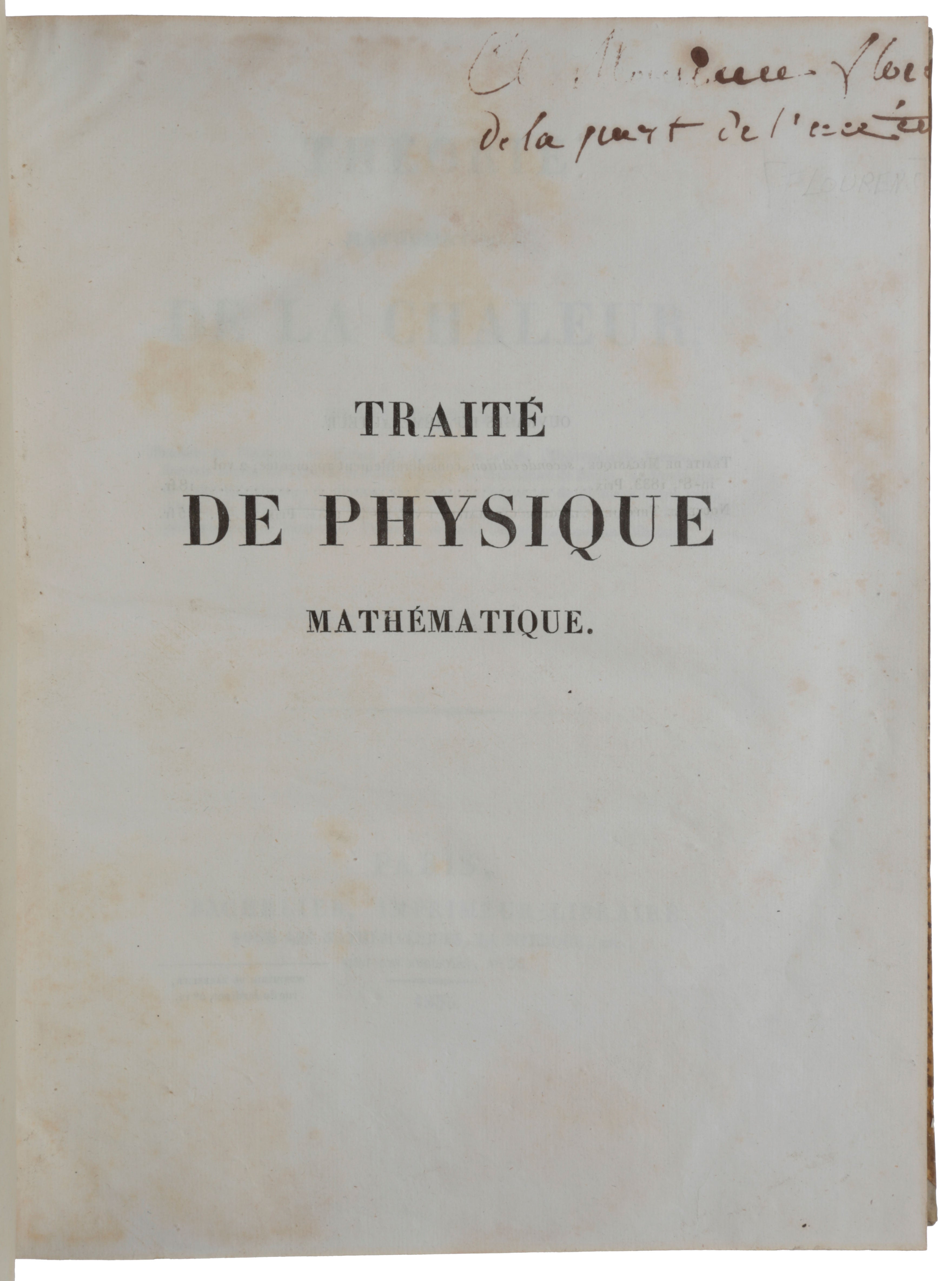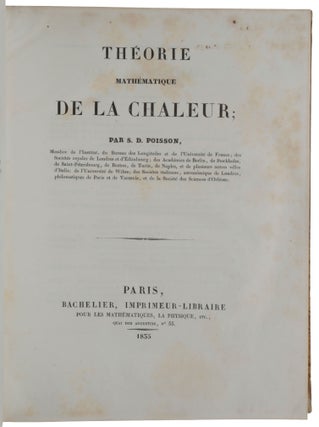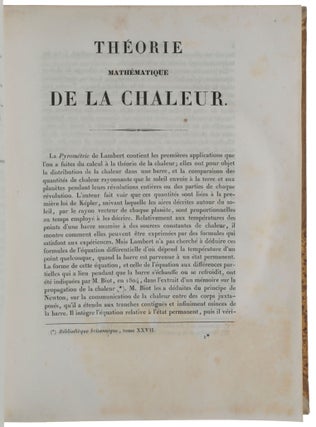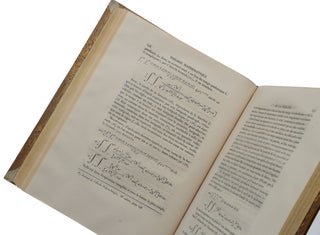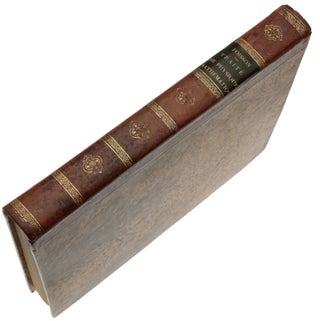Théorie mathématique de la chaleur.
Paris: Bachelier, 1835. First edition, presentation copy inscribed by Poisson to Marie Jean Pierre Flourens, of this classic work on the mathematical theory of heat conduction. “Poisson scored a point in this work by demonstrating how the conductibility of heat in the interior of bodies, far from being contained in the notion of flux as Fourier had held, must be derived from an absorption coefficient that restores a neglected functional dimension. It was in this area that … Poisson’s mechanical model for conduction of heat was the most fruitful. That conception enabled Poisson to understand on the molecular scale the complete and correct equation for radiation of heat” (DSB). “The year … 1835 saw the appearance of the next installment of Poisson’s ‘treatise of mathematical physics’: his Théorie mathématique de la Chaleur, a 532-page volume put out by Bachelier in 1,000 copies. The introduction included his history of heat theory, and was followed by accounts of, in order: physical parameters, and some aspects of radiant heat; general theory of radiant heat; principles of heat diffusion; interior diffusion in solids and liquids (including the constants defined as cumulative integrals; surface diffusion; solutions to the diffusion equation, especially Laplace's integral form but also Fourier series and surface harmonics; and the cooling of a bar of varying section and of a sphere … Poisson also laid especial emphasis on terrestrial heat distribution in two of the chapters on spheres … After reporting data from Arago and others on temperatures measured in various situations below ground, he challenged the belief of Laplace and Fourier that the heat of the earth was largely conserved internally from its creation on the grounds that the temperatures in the earth’s core would be too high: he wondered if the temperature of the universe varied in the different parts of the earth’s course, and he also considered solar, stellar and atmospheric heat” (Grattan-Guinness). Provenance: Marie Jean Pierre Flourens (13 April 1794 – 6 December 1867) was a French physician, famous for various significant discoveries relating to the nervous system, cerebral localisation and brain functions. He was known for his studies on brain physiology. He was one of the pioneers in the usage of experimental methods in neuroanatomy.
The first significant mathematical theory of heat conduction was read to the Institut de France by Jean-Baptiste-Joseph Fourier (1772-1837) in December 1807. It was not favoured with a report, and it was only through Poisson’s efforts that it was published (three months later, in abridged form). Fourier’s work excited controversy on two counts. Neither Joseph-Louis Lagrange (1736-1813), nor Pierre-Simon Laplace (1749-1827), nor Poisson, considered his solutions in trigonometric series, rather than power series, to be rigorously founded. “Fourier’s method of obtaining the partial differential equation of heat conduction excited equal controversy, for he very nearly wrote it down as a direct expression of experimental results. To the prevailing orthodoxy, rigour in physique mathématique meant rigorous deduction of observable consequences from a detailed microscopic model of atoms or molecules and their interactions. Conceptually, the net action of a system at any point in space derived from a sum (or less rigorously an integral) over the independent actions of all the discrete sources in the system. Rigour therefore required one to begin with an integral conception, then carefully to convert it to the more manageable form of a partial differential equation, and finally to find a power-series solution. Fourier violated every step in the process, beginning with his appeal directly to experimental laws …
“Notwithstanding the ‘splendour and poetry’ that William Thomson [Lord Kelvin] would see in Fourier’s treatise, his Laplacian contemporaries did not see its beauty. After more than twenty-five years of controversy, Poisson continued to elaborate in his own Théorie mathématique de la Chaleur the same kinds of objections that Laplace originally raised in 1808. All of their complaints involve the charge that Fourier’s principle for the communication of heat obscured the physical process of diffusion by incorporating from the outset two approximations: radiation extends only to infinitesimal distances in a solid, rather than to small but finite distances; and radiation rate is strictly proportional to temperature difference, rather than nearly so. Behind these complaints stood the Laplacian creed, as expressed by Laplace himself in responding to Fourier’s original memoir in 1808: ‘I have wanted to establish that the phenomena of nature reduce in the final analysis to action ad distans from molecule to molecule, and that the consideration of these actions ought to serve as the basis of the mathematical theory of these phenomena.’
“A proper derivation of the equations of heat conduction, as Poisson presented it, began with an explicit model of the relation between ponderable molecules and caloric fluid in a solid, incorporating both the free caloric radiated from the molecules and responsible for temperature, and the bound or latent caloric involved in changes of phase. His model attributed to the radiating molecules the full complexity of observable objects, including radiation to finite distances, radiation rates between molecules proportional to finite temperature differences, and a correction factor depending on absolute temperature to account for possible non-linearity. From this speculative picture, he extracted by rigorous, if tedious, expansions and approximations the general equation for the motion of heat. It involved a conductivity factor derived from the model that included variations of conductivity with temperature and with inhomogeneities in the medium. This equation differs from Fourier’s by [an additional term], which is non-zero if conductivity is a function of temperature. Poisson’s derivation implied that this term must be non-zero if radiation occurs between molecules separated by finite distances, and thus by finite temperature differences, for then the conductivity would indeed depend on absolute temperature. He regarded his much more complex procedure, therefore, as not only more rigorous but also as leading beyond a mere restatement of experimental results. It allowed theory to lead experimentation by suggesting what features to test, much as one might claim today for the hypothetico-deductive method” (Smith & Wise, Energy & Empire, pp. 158-161).
Poisson’s (1781-1840) family had intended him for a medical career, but he showed little interest or aptitude and in 1798 began studying mathematics at the École Polytechnique in Paris under the mathematicians Laplace and Lagrange, who became his lifelong friends. He became a professor at the École Polytechnique in 1802. In 1808 he was made an astronomer at the Bureau of Longitudes, and, when the Faculty of Sciences was instituted in 1809, he was appointed a professor of pure mathematics. Poisson’s most important work concerned the application of mathematics to electricity and magnetism, mechanics, and other areas of physics. His Traité de Mécanique (1811) was the standard work in mechanics for many years. In 1812 he provided an extensive treatment of electrostatics, based on Laplace’s methods from planetary theory, by postulating that electricity is made up of two fluids in which like particles are repelled and unlike particles are attracted with a force that is inversely proportional to the square of the distance between them. Poisson contributed to celestial mechanics by extending the work of Lagrange and Laplace on the stability of planetary orbits and by calculating the gravitational attraction exerted by spheroidal and ellipsoidal bodies. His expression for the force of gravity in terms of the distribution of mass within a planet was used in the late 20th century for deducing details of the shape of the Earth from accurate measurements of the paths of orbiting satellites. Poisson’s other publications include Recherches sur la Probabilité des Jugements en Matière criminelle et en Matière civile (1837), an important investigation of probability, which includes the ‘Poisson distribution’; Poisson’s contributions to the law of large numbers also appeared there. Although originally derived as merely an approximation to the binomial distribution (obtained by repeated, independent trials that have only one of two possible outcomes), the Poisson distribution is now fundamental in the analysis of problems concerning radioactivity, traffic, and the random occurrence of events in time or space. In pure mathematics his most important works were a series of papers on definite integrals and his advances in Fourier analysis, which paved the way for the research of the German mathematicians Peter Gustav Lejeune Dirichlet (1805-1859) and Bernhard Riemann (1826-1866).
A second edition appeared in 1837, with an added supplement (which is sometimes found bound with copies of the first edition sold after 1837).
Bibliotheca Chemico-Mathematica 3683; Roberts & Trent 260; Stanitz 353.
4to (258 x 199 mm), pp [vi] [1] 2-532 and 1 folding engraved plate. Contemporary half calf, gilt spine lettering, green title label. A fine clean copy. Custom cloth box.
Item #5242
Price: $5,000.00

